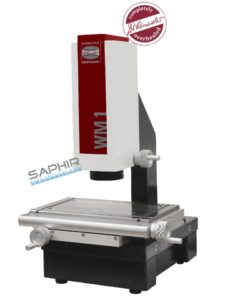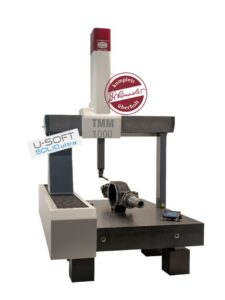



SAPHIR 7 Description
Nowadays, the SAPHIR 3D measurement and analysis software is one of the world’s best known and most successful
developments in the optical and tactile measurement technology sector. SAPHIR impresses with its clear structure and simple
operation. Thanks to its structure, SAPHIR offers multisensor capabilities for universal applications in the control, sensor and
data exchange sectors.
Version 7 includes comprehensive updates to the user interface. SAPHIR 7 is now even easier, intuitive and faster to operate.
The SAPHIR 7 functions have been updated with the latest technology – numerous new functions have been implemented and/
or improved. In particular the parameterisation and automation functions have been developed further and the QD functions
have been fully integrated in SAPHIR 7. SAPHIR 7 is thus configured for all of our devices and machines and can be used for
the full range of services.
- Interface between man and machine
The implementation capability into the complete range of multisensor measuring machines, workshop microscopes, optical measurement devices and measuring and profile projectors and the complete integration into existing environments vouch for the high flexibility and adaptability of SAPHIR.
- Accurately!
With 2D and 3D BestFit, you always get things right. Optimum integration of the measured actual data into the target data specified by model. This allows you to make optimum use of the tolerances. The following 3D formats can optionally be imported: DXF, STEP, Solid Works, Inventor, PDF, IGES, Direct X, Acis, Auto CAD (*.drw, *.dxf), Catia V4, V5, V6, Solid Edge, Pro/Engineer, NX, Parasolid, and many more. A BestFit is possible with both the 2D model sections obtained and with summarised control geometries and 3D free-form surfaces.
- Cost reductions thanks to multi-sensor system
No matter whether you have to measure coarse of finely toleranced, matt or polished, bright or dark workpieces, the right sensor is available at all times. Black/white or colour camera for incident light and transmitted light measurement, programmable LED sector incident light illumination, tactile or scanning probes (alternatively with swivel head system), a high-precision measuring laser or a confocal white light sensor are the elementary preconditions for purposeful and cost-optimised use of the measuring machine. All the sensors can be automatically changed and employed during the measurement routine without having to stop or change the measurement program. One software for all sensors – efficient and user-friendly to allow the operator to concentrate fully on the measurement application.
- Multi-axis control
The simultaneous control of various axes within a coordinate measurement machine is an elementary prerequisite for pathoptimised programming. SAPHIR not only manages the control system but also integrates all of the measurement points mathematically into the measurement. To ensure the measurement machine is suitable for universal applications, it is also possible to integrate a rotation and/or pivot axis in SAPHIR in addition to the three coordinate axes. The RPS alignment is used to determine the position of workpieces that either have no or few control geometries. The use of predefined measurement points, that are assigned to the 3D model as accurately as possible, ensures that the workpiece then has the same coordinate system as the model. Reference points can also be assigned at great distances. This means that the reference point for the module or final mounted product can feasibly be located at a distance of 1, 2, 5 m or even further away (e.g. in the vehicle coordinate system).
- Automatic detection of known and unknown contours
In the 2D area using the camera and in the 3D area using a sensing or scanning probe is a powerful tool that is complemented with 2D and 3D BestFit.
- Offline programming
Programming times = downtimes for the machines? Definitely a thing of the past! Thanks to offline programming, you can create your measurement programs in your office without any downtimes for your machinery. The programs are then loaded on to the machine via the network and can then be opened and started. This type of programming quickly pays for itself, especially when it comes to complex 2D contours and/or 3D models. And if a mistake happens to slip through the net, it can quickly be located and corrected using the integrated simulation mode.
- Dynamic wobble compensation („rotation axis alignment“)
The determined workpiece axis is retraced as part of the spatial alignment process. The edge of the workpiece thus always remains in the focus of the camera or in the specified position. Thanks to this unique function, very accurate measurements (shape and position) can be completed without complex clamping of the workpieces. Even clamping on one side in a jaw chuck guarantees repeatable and accurate measurement results.
- Quick Detect (QD)
SAPHIR 7 represents Measurement Technology 4.0 and includes integrated QD mode in all its forms. The workpiece itself is a channel of information – even without an RFID chip. SAPHIR scans all of the workpieces in the measurement range without the quantity being specified. Workpieces for which there is no program yet are also identified within their contour and converted to a DXF. The software automatically aligns the coordinate system on the workpiece and saves the image from the measurement camera for part recognition. The measurement program is created by setting the arrow heads at the relevant points of the resulting DXF file.
- Quick learning of the software thanks to workshop-oriented measurements
• Clearly structured user interface simplifies measurements.
• Detection of unknown contours.
• Quick creation of automated measurement programs.
• No programming knowledge required to create programs.
• Measuring programs are displayed in plain text in a tree structure.
• Macros, subroutines and loop programming simplify creation of the programs for continuous measurement tasks.
• Graphic representation of all measured elements and resulting design of new elements and the determined measurement values.
- Other highlights
• SAPHIR can control up to five axes.
• „Elefix“: This function calculates elements from 2D measurement points. Element issued as DXF file.
• Interfaces: Bar code/QR code/DataMatrix code reader; in-/outputs can be controlled by variables; test plan for workshop operation; QS Stat; Excel; elevation curves (polar coordinates) as text file, e.g. cam shaft; etc.
• Patented dynamic wobble compensation.
• „LearnProgram2“: Program lines can be copied from one LearnProgram to another using drag & drop.
• Configurable report: Variables and text variables possible in the report. The camera image and dimensioning can be included in the report.




